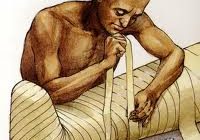Want to learn more about ancient Egyptian canopic jar chests? Read on for facts and info about this unique ritualistic item used in the elaborate burial customs of the Egyptians…
Canopic jar chests were one of the most important ritualistic items utilized in the elaborate burial customs that the Egyptians practiced. Prior to the mummification process a number of organs were removed from the dead body and placed inside Canopic jars which would in turn be placed inside a Canopic chest. The chest containing the organs would be placed adjacent to the tomb in a dedicated space known as the Canopic shrine.
According to ancient Egyptian belief the deceased had the opportunity to return to its body if it willed. This is why they considered it imperative to preserve the different organs. The entire mummification process where the organs would be taken out and stored in these jars to be kept in the chest was quite elaborate and could take a number of days.
History of Canopic Chests
The use of Canopic chests was initiated back in the second Dynasty. The Egyptians continued making use of them till the advent of the Ptolemaic period. However with the passage of time the design and style of the Canopic jar chests had gone through many modifications. The earliest proven evidence of Canopic burials dates back to the fourth Dynasty and was discovered at Giza in the tomb of Queen Meresankh III. This was during the time period of the reign of Menkaure. Examples of Canopic burials have also been found from the tombs that were made during the reign of Sneferu.
The earliest Canopic jars contained the organs in tightly sealed wooden boxes. In other cases they would be placed inside pottery or stone jars and then the jars would be shut with domed or flat lids. The chests themselves were carved out of soft stone. In other cases the chest was actually carved into the floor or wall of a particular tomb. By the sixth Dynasty the Canopic jar chests were being made out of granite. By the 18th century a wide variety of materials were being used to create the chests including wood, cartonnage, limestone and calcite.
Evolution of Canopic jars
The Canopic jars that contained the organs of the dead body also went through a series of modifications over time. They started out as simple stone jars with flat lids. The first modification came in the form of domed lids. Following this the Egyptians experimented with a number of different materials which they used to create the jars. These jars contained four organs which were the liver, the stomach, the lungs and the intestines. Each of these organs was associated with specific deities.
With the passage of time the jars were modified conceptually as well as physically. In terms of their physical appearance they were now given lids that depicted a sculpture of jackal heads. These were considered to be representing the four sons of Horus. Each organ was then assigned to one of the sons who were in turn protected by another powerful Egyptian deity.




